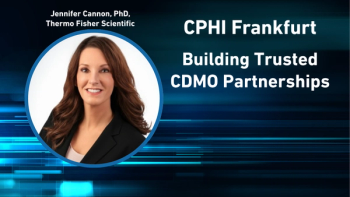
- Pharmaceutical Technology-02-01-2014
- Volume 2014 Supplement
- Issue 1
Partnership Models Structure R&D Change
Pharmaceutical companies are adopting multiple choice partnership strategies to meet the challenges of today's R&D instead of being focused primarily on internal development.
A revolution is under way in the biopharmaceutical industry as it faces global economic and demographic pressures, rising customer expectations, and new clinical development models. At the same time, emerging market growth opportunities beckon. R&D stands at the vanguard of this revolution. In fact, some 35% of life-science companies have revamped their R&D models in the past three years, according to PricewaterhouseCoopers’ (PwC) Health Research Institute (HRI) research.
The biopharmaceutical industry, already among the most research-intensive industries, faces an immense challenge to develop a constant stream of profitable new products. Thousands of drug compounds are in some phase of clinical trial today. There’s no guarantee, however, that the comparatively few compounds that launch will earn enough to counteract lost sales from patent expirations.
Additionally, companies now have to factor in therapeutic development along with biomarker/companion diagnostic development for most new products. For pharmaceutical companies, the advantage in partnering with diagnostic companies can reflect that more drugs require or benefit from having a companion diagnostic. In many cases, the pharmaceutical company itself does not have the expertise in diagnostics, including diagnostics development and the necessary regulatory pathway being different from those for Pharma.
Opening the door to new partnerships
Companies are confronting this challenge by shifting R&D models to be more externally focused to share costs and risk. They are changing how they conduct R&D, not only reconfiguring existing operations, but also looking outside for promising new alliances that will help boost capabilities and replenish the pipeline more rapidly. Partnerships with academic medical centers (AMCs) and third parties, such as contract research organizations (CROs), are the two most common, aside from government contracts. In this new pressure-cooker environment, traditional competitors are teaming up to tackle shared R&D challenges. Consortiums, alliances with foundations, and crowdsourcing are among the new approaches. Done well, these relationships complement in-house R&D and allow companies to share both risk and reward with external partners.
As shown in Figure 1, some 29% of companies have one or more partnerships, with another 27% reporting having at least one corporate research partnership or consortium, and 31% have partnerships with AMCs.
Today’s partnership models
Five partnership models predominate: Consortia, alliances, CROs, AMC relationships, and crowdsourcing.
Consortia. Sometimes the need to confront basic issues can justify collaboration, or a pre-competitive alliance, among firms that usually compete. The semiconductor industry created SEMATECH, a not-for-profit consortium, to tackle shared manufacturing challenges. The pharmaceutical sector appears to be taking similar steps. In 2012, 10 large drug makers formed a consortium, TransCelerate, to reduce drug development costs and exchange ideas on standardizing methods of discovery and development. TransCelerate has an ambitious agenda to develop clinical data standards and a risk-based monitoring methodology designed to satisfy guidance provided by FDA for clinical trials (1).
Boehringer Ingelheim and Eli Lilly took on the challenge of medication adherence by teaming up to engage patients with My Well Planner, a program launched in 2012 that targets Type 2 diabetes patients. Based on a behavioral-change approach, it offers personalized information that adjusts to patient use. The program allows patients with type 2 diabetes to partner with clinicians to set modest lifestyle goals at their own pace, building toward bigger goals. A scoring mechanism gives the patient a sense of accomplishment and momentum rather than just indicating compliance (2).
Alliances. Much of the industry has embraced alliances as a way to tap into more scientific minds. BioPontis Alliance, a North Carolina-based investment firm, connects academia and established companies. The consortium aims to reduce risk by identifying the most promising therapies in academia and developing partnerships with for-profit firms or manufacturers. To date, 10 academic institutions, three large pharmaceutical companies, and one CRO participate.
Some alliances involve a foundation, such as the research partnership of the Cystic Fibrosis Foundation (CF Foundation) and Vertex initiated in 2000. This partnership has resulted in the development and launch of Kalydeco, a targeted therapy for some cystic fibrosis patients.
CF Foundation invested $76 million contingent on meeting certain research milestones, and in return, received future guarantees on sales royalties. The Foundation also provided access to its national clinical trials network for the research, helped recruit patients, provided leading practices in clinical trial design, and helped define outcome measures as understanding of the disease evolved. Kalydeco was reviewed and approved within three months by FDA.
Contract research organizations. CROs historically focused on services such as data management and site monitoring. Today, CROs represent one of the fastest growing partnership approaches and can range from early-stage development and product design through clinical trials and post-launch studies. Next to government-sponsored research, CROs are the most common type of partnership (see Figure 1) and now encompass more than 40% of drug discovery and development spending (1, 3). Beyond clinical trials, CROs are becoming more tightly embedded with Pharma, sharing both risk and reward, while moving away from a historic fee-for-service model.
Some of the most interesting work today involves CROs looking to gain access to and integrate data from sponsors, payers, and providers with the intent to enable predictive analytics for clinical site selection and monitoring levels. The immediate intent is to reduce the time and cost to move a drug through development. It is also, however, anticipated that effective assessment of such data will enable pharmacoeconomic evaluation and drug-safety assessment.
One example is the strategic partnership announced by Quintiles and Allscripts to jointly develop software solutions to enable improvements to the drug-development process and demonstrate the value of biopharmaceutical products in the real world. The partners’ goal is to develop products that are designed to significantly reduce some of the bottlenecks that traditionally impede clinical research, outcomes, education, and proof of new compound safety, effectiveness, and value. Their areas of focus include late-phase research, recruiting for and monitoring of clinical trials, and post-market surveillance--with the objective to create new solutions to enable customers to leverage de-identified longitudinal data from many sources in a HIPAA-compliant manner.
Still, deeper CRO relationships are not pervasive. A survey by HRI found that 38% (see Figure 2) of survey respondents characterize their partnership with a CRO as highly integrated and strategic, while 47% describe it as arm’s length, suggesting that some companies still see CROs as low-cost vendors for limited services and may be missing a broader opportunity. A strategic CRO partnership requires breaking out of a project-oriented mindset, sharing more proprietary information, and considering the full range of capabilities a CRO offers. This approach engages the CRO in every stage of the R&D process, from early-stage planning of drug development to clinical trials and beyond.
University and academic medical center relationships. Many companies are going straight to an external source of early-stage innovation and scientific talent: the AMCs and research institutions that account for an estimated 13% of total US R&D expenditures (4). All large pharmaceutical companies have established at least one AMC partnership, often specific to a disease. And the survey highlighted in HRI’s “The future of academic medical centers,” reports that 31% of pharmaceutical and medical device companies engage with AMCs (5).
Pfizer’s Global Centers for Therapeutic Innovation was established in 2010 to pair teams of researchers from academic medical centers with company scientists. Researchers gain access to Pfizer’s library of drug candidates and work side by side with Pfizer scientists, while Pfizer retains first rights on any biologics developed. And in 2012, Novartis and University of Pennsylvania launched a $20 million effort to investigate personalized cancer therapies, citing Penn researchers’ intellectual capacity as a reason for the agreement (1).
Crowdsourcing. For years, technology firms such as Apple and Google have used public contributions (“the crowd”) to supplement internal software development. In the life sciences industry, two major events boosted the cause of open innovation in 2012. First, the National Institutes of Health (NIH) announced an initiative pairing industry-abandoned drug compounds with NIH-funded researchers. Three companies made the initial asset donation, with five more following suit. The compounds have gone through preclinical or Phase I testing before donation. NIH provided $20 million in funding for grant applicants in addition to streamlined legal and administrative documents between the researchers and drug companies. Second, GlaxoSmithKline announced the open availability of 4500 clinical trials results and gave away the chemistries for hundreds of drug compounds that may fight tuberculosis (1). Outside scientists now have a complete view of all clinical trial data including adverse effects that may have been underreported in the past.
Another company, Transparency Life Sciences, operates a drug-development crowdsourcing website that seeks the talents of two groups--patients and researchers. Three projects today target Crohn’s disease, multiple sclerosis, and Parkinson’s disease. Patients contribute ideas on real-world outcomes they hope to achieve with a treatment. Researchers help review compounds that have made it to Phase II, where abandonment rates can be high. Professional development and a chance to contribute ideas outside their field motivate some scientific contributors.
A strategic business model approach to partnership solutions
Healthcare companies, with their traditional concentration by specialty on narrow diagnostic or therapeutic niches, historically made few efforts to integrate or even coordinate care. But driven by changing industry dynamics and healthcare reform, companies across the health spectrum, including those in Pharma, are now compelled to shift to a more systems-based approach that reflects an integrated professional continuum.
The volume-based, fee-for-service approach to healthcare is being supplanted at the provider level by one that rewards quality and outcomes, a change driven by payers’ demand for results and the growing capacity of personalized care being made possible by genomics and similar advances. Pharma is facing increased pressure to deliver greater value, generally defined as providing better outcomes at lower cost. Increasingly, this is a global challenge. Both developed nations, with their aging populations and costly technologies, and emerging nations, with fast-growing populations, scarcity of medical professionals, and constrained finances, find cost a key variable in care.
In response to each of these forces, pharmaceutical companies are changing their focus in three important ways: shifting from selling “products” to providing solutions; from focusing on silos to a broader systems approach; and from generating profits by increasing volume to winning by delivering greater value. In turn, these strategies are transforming the fundamental business model for pharmaceutical companies, resulting in companies taking a more comprehensive approach that compels them to seek to “own” the diseases or conditions their products are intended to treat.
In healthcare, chronic disease states—such as diabetes, some forms of cancer and, in some countries, AIDS—require active management over a lifetime. In the United States, more than 80% of healthcare expenditures relate to such chronic conditions (6). In such cases, “owning the disease” enables a company to provide behavioral, diagnostic, and therapeutic solutions on an integrated platform, thereby improving patient outcomes, lowering system costs, and capturing the full value of their solutions and innovation.
The following example of applying an “Owning the Disease” business model shows the value of partnership strategies that cross established business model boundaries.
Merck Serono and Easypod--Owning growth disorders. Merck Serono S.A. has deployed a solution within the United Kingdom market to own human growth hormone therapy for endocrine and metabolic disorders. It is doing so by integrating diagnostic screening, counseling, and monitoring services with the Easypod wireless injection device. It partnered with international design and innovation consultancy PDD to develop the device. Approved for use in more than 40 countries, including the US and the European Union, the Easypod is employed in the injection of pharmaceuticals, and merges the delivery of drugs, the documentation of the dosages, and the monitoring of compliance. Data are shared automatically with physicians to promote compliance and integrated into electronic medical records for provider accessibility. The use of the Easypod reflects a changed business model. Merck Serono no longer concentrates solely on selling pharmaceuticals to providers but instead delivers value, with compensation linked to overall results. Quality of results, rather than quantity of sales, determines profitability, which aligns Merck Serono with the primary payer, the National Health Service (NHS). Because the higher levels of patient compliance with medication regimens produce better health and reduced lifetime treatment costs, the overall cost of the therapy for the NHS is lower, while Merck Serono enjoys greater market share and higher profits (7).
Partnerships help meet the innovation imperatives
The innovation process is fundamentally different from most other business activities and requires a different logic, infrastructure, and style of management. Partnership strategies can help pharmaceutical companies achieve their innovation needs by helping to deliver the following three key imperatives of innovation:
Be ambidextrous. Companies must operate as “lean startups”—importing the “fast, frequent, frugal failure” model of innovative startups. Concurrently, they must maintain lean six sigma discipline to sustain their core businesses.
Measure innovation in new ways. Companies must manage the innovation cycle differently than managing operations by setting different goals and measurement methods.
Collaborate to get closer to the patient. Pharmaceutical companies must look increasingly to external customers (from healthcare providers to pharmacies to patients), partners, and even competitors to help them generate valuable insights and widen the funnel of ideas flowing into the organization.
Conclusion
Disease needs and efficiency to adapt to the new health economy require pharmaceutical R&D to embrace increased flexibility and explore a greater range of partnership approaches. Partnerships can be instrumental in helping R&D achieve the innovation needed to remain competitive in the face of these industry challenges. An “owning-the-disease” approach to business and partnering offers a thorough solution aligned with the shifting dynamics driving change in healthcare.
References
1. PwC Health Research Institute, New Chemistry (PwC, February 2013).
2. PwC Health Research Institute, Customer Experience in the Pharmaceutical Sector (PwC, November 2013).
3. PwC Health Research Institute, Survey on Human Capital in the Health Industries (2012).
4. BIO, “The Economic Contribution of University/Nonprofit Inventions in the United States: 1996-2010,” BIO (2012).
5. PwC Health Research Institute, The Future of Academic Medical Centers: Strategies to avoid a margin meltown (PwC 2010).
6. G. Anderson, “Chronic Care: Making the Case for Ongoing Care,” RWJF.org P.16. (Robert Wood Johnson Foundation, March 2010).
7. PwC Health Institute, Owning the Disease (PwC, August 2011).
About the Authors
Benjamin K. Gill and Jim Prutow are both principals in PwC’s Health Industries practice, focused on the pharmaceutical and life-sciences sector.
Articles in this issue
almost 12 years ago
Global Markets Demand Local Knowledgealmost 12 years ago
Clinical-Trial Material Supply by Way of Shanghaialmost 12 years ago
Managing Clinical Development Risk: Pharma and CRO Reportalmost 12 years ago
A New Dawn for Western CMOsalmost 12 years ago
Outsourcing Trends in Biopharmaceutical Manufacturingalmost 12 years ago
Ensuring Sound Bioanalytical Methods Transferalmost 12 years ago
Jubilant HollisterStierNewsletter
Get the essential updates shaping the future of pharma manufacturing and compliance—subscribe today to Pharmaceutical Technology and never miss a breakthrough.





